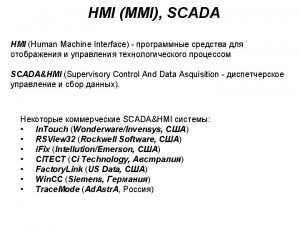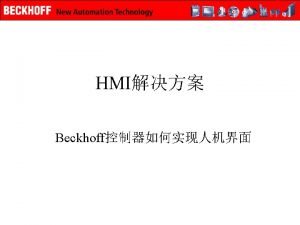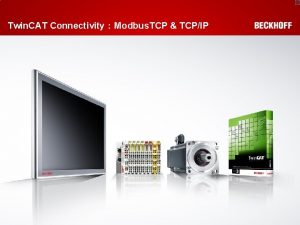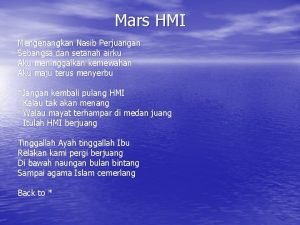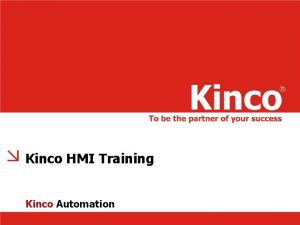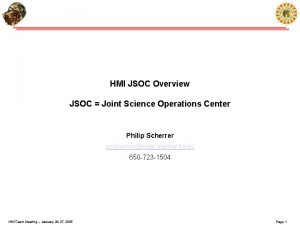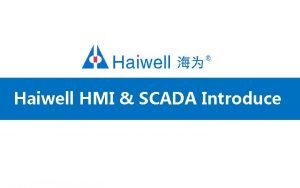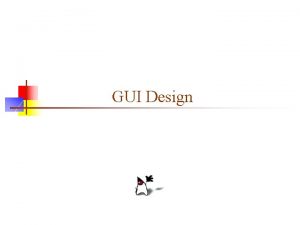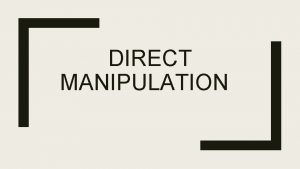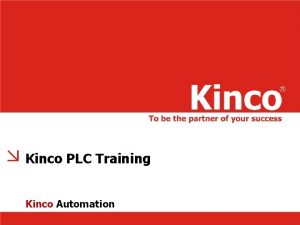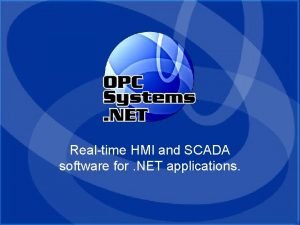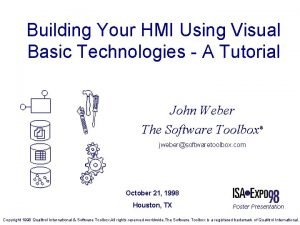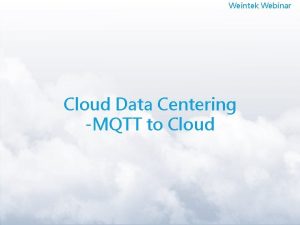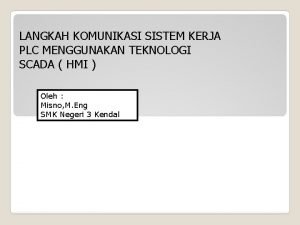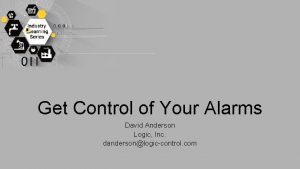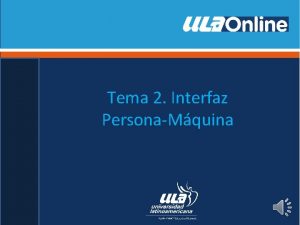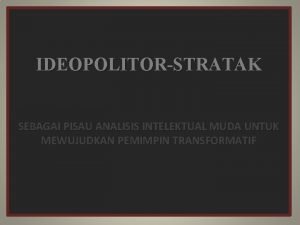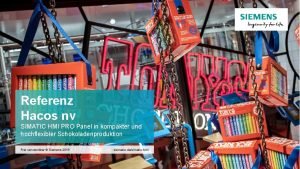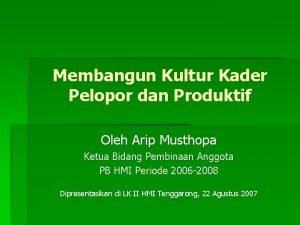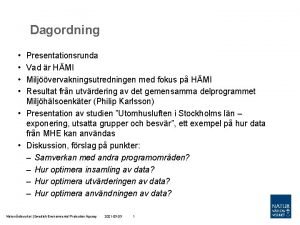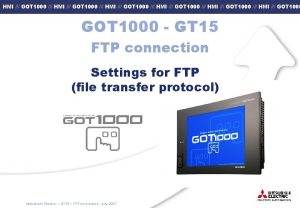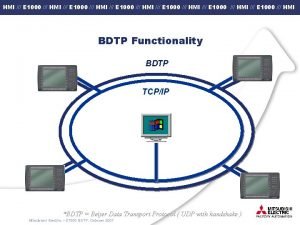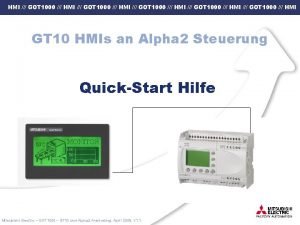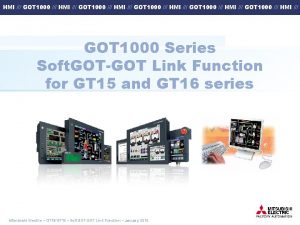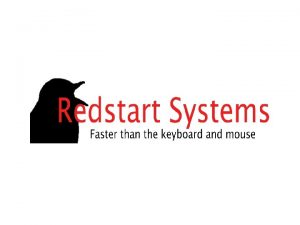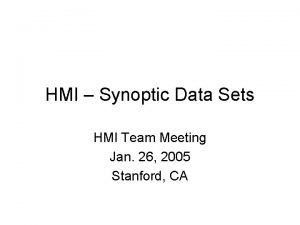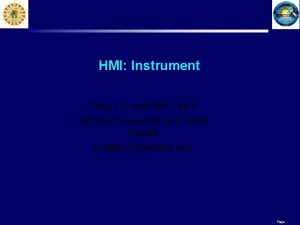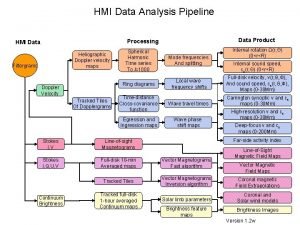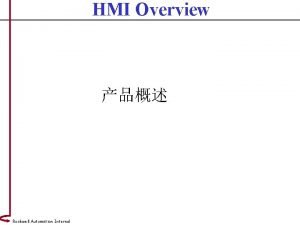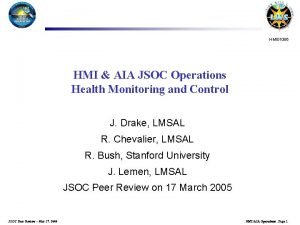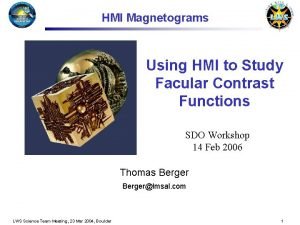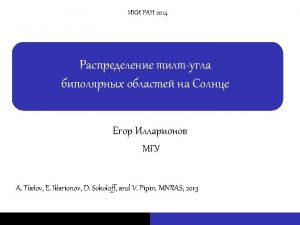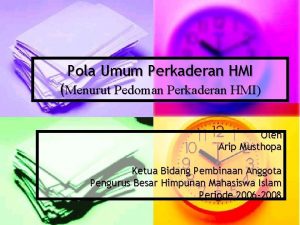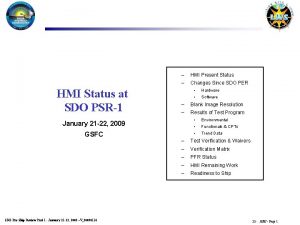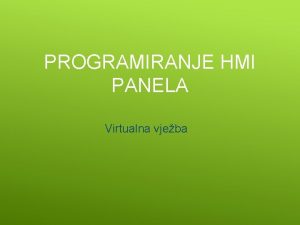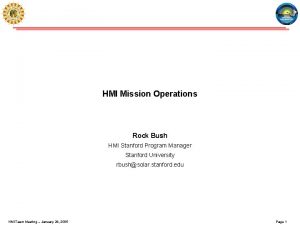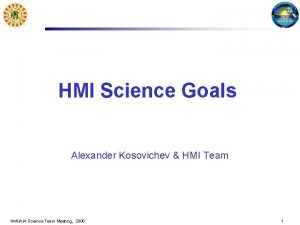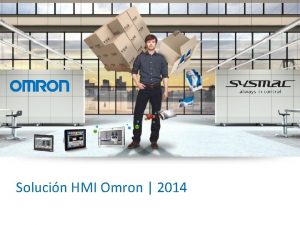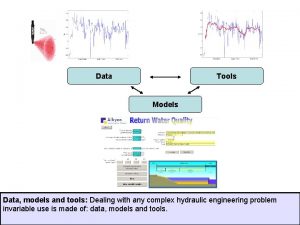HMI MEETING 2011 Models and Tools for HumanMachine

































- Slides: 33

HMI MEETING 2011 Models and Tools for Human-Machine Interaction From Pattern-based User Interfaces To Conceptual Schemas and Back (based on ER’ 2011) Ravi Ramdoyal and Anthony Cleve Centre of Excellence in Technologies of Information and Communication Charleroi, Belgium Lab. of DB Application Engineering PRe. CISE Research Centre Faculty of Computer Science, University of Namur, Belgium R. Ramdoyal & A. Cleve – From Pattern-based User Interfaces To Conceptual Schemas and Back (LVL HMI Meeting 2011) 11

Agenda From Pattern-based User Interfaces To Conceptual Schemas and Back • • • Introduction Research context Proposal Discussion Conclusion R. Ramdoyal & A. Cleve – From Pattern-based User Interfaces To Conceptual Schemas and Back (LVL HMI Meeting 2011) 22

Introduction • Necessity to involve end-users in Information Systems Engineering • Especially true during Requirements Engineering phase • Requirements are typically expressed through conceptual models (e. g. ER) • Graphical representation • Intrinsically complex • Difficult to apprehend by the laymen • Electronic forms • Natural, intuitive, linkable to the ER model Forward / Reverse Engineering R. Ramdoyal & A. Cleve – From Pattern-based User Interfaces To Conceptual Schemas and Back (LVL HMI Meeting 2011) 33

Introduction • Approaches using electronic forms to convey conceptual requirements • Batini et al. (1984), Choobineh et al. (1992), Kösters et al. (1996), Rollinson and Roberts (1998), Rode et al (2005), Terwilliger et al. (2006), Yang et al. (2008) • (Too) rich UIDLs • (Too) poor schema structures IS-A UIDLs FD … • The RAINBOW approach overcomes these limitations [CAi. SE’ 10, IJCSIS’ 11] • Simple form-based interfaces model with direct conceptual counterparts • Effective to express, discuss and validate conceptual requirements • Overall process tedious at times • Objective : improve this process • Identify critical semantic patterns of conceptual schemas • Define corresponding widget patterns • Steer the drawing process using such patterns + specific heuristics R. Ramdoyal & A. Cleve – From Pattern-based User Interfaces To Conceptual Schemas and Back (LVL HMI Meeting 2011) 44

Agenda • Introduction • Research context • Overview of the RAINBOW approach • Current form-based interface model • Forms vs Final schema • Proposal • Discussion • Conclusion R. Ramdoyal & A. Cleve – From Pattern-based User Interfaces To Conceptual Schemas and Back (LVL HMI Meeting 2011) 55

Research context > Overview of the RAINBOW approach (1/2) • A collaborative and interactive approach to design the conceptual schema of an IS • Adaptation and integration of techniques from different disciplines • User-drawn form-based interfaces as a two-way communication channel • Communication of static data requirements between end-users and analysts • Structure of the approach • Seven dedicated steps • Simple structure for conceptual schemas • Atomic attributes, binary relationships, … • Advanced constraints • Integrity constraints, existence constraints, identifiers, functional dependencies, … R. Ramdoyal & A. Cleve – From Pattern-based User Interfaces To Conceptual Schemas and Back (LVL HMI Meeting 2011) 66

Research context > Overview of the RAINBOW approach (2/2) user-drawn form-based interfaces Represent hierarchised and unified pre-integrated schema conceptual schemas data samples Investigate Adapt Nurture Wander Objectify database queries prototype Bind integrated schema validated constraints and dependencies R. Ramdoyal & A. Cleve – From Pattern-based User Interfaces To Conceptual Schemas and Back (LVL HMI Meeting 2011) 77

Research context > Current form-based interface model • Most usual widgets with direct conceptual counterpart R. Ramdoyal & A. Cleve – From Pattern-based User Interfaces To Conceptual Schemas and Back (LVL HMI Meeting 2011) 88

Research context > Forms vs Final schema (1/4) Represent R. Ramdoyal & A. Cleve – From Pattern-based User Interfaces To Conceptual Schemas and Back (LVL HMI Meeting 2011) 99

Research context > Forms vs Final schema (2/4) Adapt R. Ramdoyal & A. Cleve – From Pattern-based User Interfaces To Conceptual Schemas and Back (LVL HMI Meeting 2011) 10 10

Research context > Forms vs Final schema (3/4) Investigate Nurture Bind ? ? ? NON DETERMINISTIC R. Ramdoyal & A. Cleve – From Pattern-based User Interfaces To Conceptual Schemas and Back (LVL HMI Meeting 2011) 11 11

Research context > Forms vs Final schema (4/4) • Loss of representativeness between the forms and the schema • Sequentiality of the overall process • Drawing step • Several (non deterministic) analysis step • How can we merge these steps to ensure the co-evolution of the forms and their underling conceptual schema? R. Ramdoyal & A. Cleve – From Pattern-based User Interfaces To Conceptual Schemas and Back (LVL HMI Meeting 2011) 12 12

Agenda • Introduction • Research context • Proposal • Formal overview • Missing constructs • A new pattern-based form model • A heuristic-driven process • Converse process • Discussion • Conclusion R. Ramdoyal & A. Cleve – From Pattern-based User Interfaces To Conceptual Schemas and Back (LVL HMI Meeting 2011) 13 13

Formal overview • Current process • (1) Surjective mapping M HCI M ER • (2) Non deterministic interpretation M ER- M ER • Improved process • An extended form model M HCI* • A new surjective mapping (3) M HCI* M ER • A set of semantic and structural heuristics H (on-the-fly integration) R. Ramdoyal & A. Cleve – From Pattern-based User Interfaces To Conceptual Schemas and Back (LVL HMI Meeting 2011) 14 14

Missing constructs (1/2) BINARY RELATIONSHIP TYPES IS-A HIERARCHIES R. Ramdoyal & A. Cleve – From Pattern-based User Interfaces To Conceptual Schemas and Back (LVL HMI Meeting 2011) 15 15

Missing constructs (2/2) • Typical structural redundancies as IS-A or relationship types • Typical relationship patterns (non bijective) R. Ramdoyal & A. Cleve – From Pattern-based User Interfaces To Conceptual Schemas and Back (LVL HMI Meeting 2011) 16 16

A new pattern-based form model • Unchanged widgets • Form containers top level entity types • Inputs monovalued simple attributes • Selections mono/multivalued simple attributes • Buttons procedural units • Recombination of fieldsets and tables • Composed fields monovalued compound attributes • Category containers IS-A hierarchies • Pattern containers multivalued compound attributes and relationship types: • Complementary containers concepts complementing the current container • Component containers compositions • Contributor containers aggregations • Specimen containers materialisations • Visible/Hidden referential attributes R. Ramdoyal & A. Cleve – From Pattern-based User Interfaces To Conceptual Schemas and Back (LVL HMI Meeting 2011) 17 17

A heuristic-driven process (1/2) • Detect and process semantic ambiguities on-the-fly Arbitrate + Uniform R. Ramdoyal & A. Cleve – From Pattern-based User Interfaces To Conceptual Schemas and Back (LVL HMI Meeting 2011) 18 18

A heuristic-driven process (2/2) • Detect and process structural redundancies on-the-fly Characterize + Adapt R. Ramdoyal & A. Cleve – From Pattern-based User Interfaces To Conceptual Schemas and Back (LVL HMI Meeting 2011) 19 19

New representation of the forms R. Ramdoyal & A. Cleve – From Pattern-based User Interfaces To Conceptual Schemas and Back (LVL HMI Meeting 2011) 20 20

Converse process • Generating forms from a schema is straightforward • Generating RAINBOW forms from a given schema is less trivial • Schema transformation and annotation • Restrict inter-concept relationships to binary RT and IS-A hierarchies • Explicit if ET must appear as a form or a compound attribute • Identify patterns and specify the roles of each ET in a RT • Specify which elements should be hidden/visible in the forms • Such modifications enable to obtain a bijection between the schema and the forms R. Ramdoyal & A. Cleve – From Pattern-based User Interfaces To Conceptual Schemas and Back (LVL HMI Meeting 2011) 21 21

Discussion • Generalization of the principles of the RAINBOW approach: • Integrated and iterative process instead of a sequential process • Coevolution of the interfaces and the conceptual schema • Reduced articulatory distance • The RAINBOW approach is a proven process, but there are still tests to be led • Expressiveness of the new form model • Usability of the form model R. Ramdoyal & A. Cleve – From Pattern-based User Interfaces To Conceptual Schemas and Back (LVL HMI Meeting 2011) 22 22

Conclusion • Simple form-based interface model • Understandable and expressive counterpart to conceptual schemas • Extension of the principles of the RAINBOW approach • Surjective mapping between form model and ER model • Heuristics on-the-fy characterisation of intra-concept relationships • Inverse translation • Future works • Integrate constraints and dependencies • Improve tool support • Continue the experimentation and validation process R. Ramdoyal & A. Cleve – From Pattern-based User Interfaces To Conceptual Schemas and Back (LVL HMI Meeting 2011) 23 23

Thank you for your attention… Any questions? www. cetic. be www. info. fundp. ac. be www. fundp. ac. be/precise Ravi Ramdoyal Anthony Cleve ravi. ramdoyal@cetic. be anthony. cleve@fundp. ac. be www. cetic. be/ravi-ramdoyal www. info. fundp. ac. be/~acl be. linkedin. com/in/raviramdoyal be. linkedin. com/in/anthonycleve R. Ramdoyal & A. Cleve – From Pattern-based User Interfaces To Conceptual Schemas and Back (LVL HMI Meeting 2011) 24 24

BONUS R. Ramdoyal & A. Cleve – From Pattern-based User Interfaces To Conceptual Schemas and Back (LVL HMI Meeting 2011) 25 25

Tool support • The RAINBOW Tool Kit • Written in Java, using different libraries: • QT Jambi, for graphical rendering • Secondstring, for string comparison • Word. Net, for ontological comparison • DB-Main, to interact with its ER repository • … R. Ramdoyal & A. Cleve – From Pattern-based User Interfaces To Conceptual Schemas and Back (LVL HMI Meeting 2011) 26 26

Validation • Two main research questions : 1. Do the RAINBOW approach and tool support help end-users and analysts communicate (i. e. express, capture, validate) static data requirements to each other? 2. What is the quality of the conceptual schema produced using the RAINBOW approach? • Non trivial research questions • 2 preliminary studies to : • Define and validate an experimentation canvas • Participant / Observer for the effectiveness • Brainstorming / Focus group for the quality • Get a first insight on the implementation of the approach R. Ramdoyal & A. Cleve – From Pattern-based User Interfaces To Conceptual Schemas and Back (LVL HMI Meeting 2011) 27 27

Validation • Encouraging results: • The chosen widgets seem sufficient to express concepts • But different drawing behaviours (pro-activity, creativity, aesthetics. . . ) • The approach induces discussions on the specifications that are not supported by it • User involvement : • The end-users were enthusiastic • The guidance and good will of the analyst are vital! • Tool support: a successful proof-of-concept • Produced schemas comparable to raw hand-made schemas • An adequate experimentation canvas • Experimentation to be continued. . . in another thesis? R. Ramdoyal & A. Cleve – From Pattern-based User Interfaces To Conceptual Schemas and Back (LVL HMI Meeting 2011) 28 28

Comparison of existing approaches NB: The symbol "/" means that no details were explicitly provided for the given characteristic. R. Ramdoyal & A. Cleve – From Pattern-based User Interfaces To Conceptual Schemas and Back (LVL HMI Meeting 2011) 29 29

Discussion > Specificities (1/2) • Integration of different disciplines • Identify, tailor and integrate their principles and techniques • End-users as major stakeholders throughout the data requirements process • Interfaces as a means rather than an end product • Interfaces as a communication language, with its possible flaws • Collaboration with the analyst • Using Reverse Engineering for the purpose of Forward Engineering • « Build the truth » rather than « Find the truth » • Controlled / monitored input R. Ramdoyal & A. Cleve – From Pattern-based User Interfaces To Conceptual Schemas and Back (LVL HMI Meeting 2011) 30 30

Discussion > Specificities (2/2) • A modular and non standard view integration process • Different types of potential users • Non linear approach • System evolution support through a transformational approach • Traceability and reversibility • Preservation and propagation of (previous) decisions • A rich and relevant part of requirement specifications • Dependencies, constraints, IS-A’s … • Major part of the application domain • Extensible through other elicitation techniques R. Ramdoyal & A. Cleve – From Pattern-based User Interfaces To Conceptual Schemas and Back (LVL HMI Meeting 2011) 31 31

Discussion > Possible improvements • Extending the approach • Develop and implement BIND and WANDER • Incorporate dynamic aspects (in the forms and their use) • Improve specification reusability through the tool support • Refine the semantic and structural analysis • Expand the analysis of data samples, constraints and dependencies • Improving tool support • Fine-tuning the tools • User-friendliness (usability, ergonomy, …) • Pursuing the experimentation based on a improved canvas • Multiple cases, multiple settings, long time span • Update the canvas to include the findings of the preliminary case studies R. Ramdoyal & A. Cleve – From Pattern-based User Interfaces To Conceptual Schemas and Back (LVL HMI Meeting 2011) 32 32

Publications • 2011 Ravi Ramdoyal, Jean-Luc Hainaut, Involving End-Users In Database Design - The RAINBOW Approach in International Journal on Computer Science and Information Systems (IJCSIS) Special issue on “Users and Information Systems, International Association for Development of the Information Society (IADIS) (accepté pour publication). • 2011 Ravi Ramdoyal, Anthony Cleve, From Pattern-based User Interfaces to Conceptual Schemas and Back, in Proceedings of ER'2011, Bruxelles, Belgique, Octobre 2011, LNCS (accepté pour publication). • 2011 Ravi Ramdoyal, Jean-Luc Hainaut, Interactively Eliciting Database Constraints and Dependencies, in Proceedings of CAi. SE 2011, Londres, Royaume-Uni, Juin 2011, LNCS (accepté pour publication). • 2010 Ravi Ramdoyal, Anthony Cleve, Jean-Luc Hainaut, Reverse Engineering User Interfaces for Interactive Database Conceptual Analysis, in Proceedings of CAi. SE 2010, Hammamet, Tunisie, Juin 2010, LNCS, p 332 -347. • 2010 Ravi Ramdoyal, Reverse Engineering User-Drawn Form-Based Interfaces for Interactive Database Conceptual Analysis, in Proceedings of CAi. SE Doctoral Consortium 2010, Hammamet, Tunisie, Juin 2010, CEUR Workshop Proceedings, volume 593. • 2009 Ravi Ramdoyal, Anthony Cleve, Anne-France Brogneaux, Jean-Luc Hainaut, Rétro-ingénierie d'interfaces utilisateur pour l'analyse conceptuelle de bases de données, in Proceedings of the 25èmes Journées en Bases de Données Avancées (BDA 2009), Namur, Belgique, Octobre 2009. • 2007 Ravi Ramdoyal, Anne-France Brogneaux, Julien Vilz, Jean-Luc Hainaut, Research de recouvrements dans une collection de schémas de base de données, in Proceedings of the DECOR Workshop, EGC 2007, Namur, Belgique, Janvier 2007. • 2006 Julien Vilz, Anne-France Brogneaux, Ravi Ramdoyal, Vincent Englebert, Jean-Luc Hainaut, Data Conceptualisation for Web-Based Data-Centred Application Design, in Proceedings of CAi. SE 2006, Luxembourg, Juin 2006, p 205 -219. • 2005 Anne-France Brogneaux, Ravi Ramdoyal, Julien Vilz, Jean-Luc Hainaut, Deriving User-requirements From Human. Computer Interfaces, in Proceedings of the 23 rd IASTED International Multi-Conference on Applied Informatics (Databases and Applications), Innsbruck, Autriche, Fevrier 2005, p 77 -82. R. Ramdoyal & A. Cleve – From Pattern-based User Interfaces To Conceptual Schemas and Back (LVL HMI Meeting 2011) 33 33
 Hmi 2011
Hmi 2011 What is the difference between model and semi modals
What is the difference between model and semi modals What is meeting and types of meeting
What is meeting and types of meeting Types of meeting
Types of meeting Hmi mmi
Hmi mmi Today meeting or today's meeting
Today meeting or today's meeting Today meeting or today's meeting
Today meeting or today's meeting Hmi viggo
Hmi viggo Plc hmi web
Plc hmi web Twin cat 3
Twin cat 3 Mars hmi
Mars hmi Kinco hmiware
Kinco hmiware Jsoc hmi
Jsoc hmi Hmi haiwell
Hmi haiwell Gui vs. hmi
Gui vs. hmi Examples of direct manipulation
Examples of direct manipulation Hmi web browser
Hmi web browser Kinco hmi example program
Kinco hmi example program Opc systems
Opc systems Hmi visual studio
Hmi visual studio Mqtt weintek
Mqtt weintek Pc to plc communication
Pc to plc communication The alarm management handbook
The alarm management handbook Tipos de hmi
Tipos de hmi Ideopolitor stratak
Ideopolitor stratak Hmi pro
Hmi pro Materi kmo lk 1 hmi pdf
Materi kmo lk 1 hmi pdf Pro vision hmi
Pro vision hmi Vad är hmi
Vad är hmi Formuö
Formuö Typiska novell drag
Typiska novell drag Tack för att ni lyssnade bild
Tack för att ni lyssnade bild Ekologiskt fotavtryck
Ekologiskt fotavtryck Varför kallas perioden 1918-1939 för mellankrigstiden?
Varför kallas perioden 1918-1939 för mellankrigstiden?




